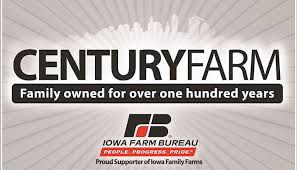Category: Small town
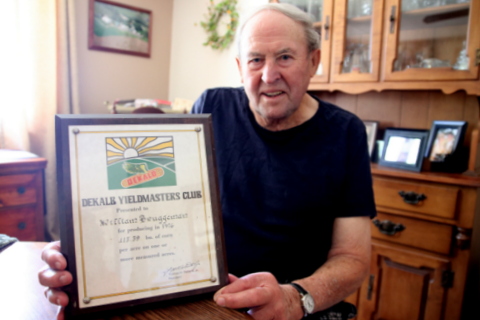
Memories of Carroll County, Iowa, Century Farm Endure
Among the most remarkable parts of rural Iowa are the thousands of families who have owned the same land for 100 years. I’ve had the chance to interview hundreds of Iowa families who own Century Farms. Some of these folks, like Bill Bruggeman, share the kinds of stories you never forget.
After Bill passed away this week (read his touching obituary here), I felt that sharing his story would be a fitting tribute to a dedicated, kind, hard-working Iowa farmer I respect greatly Here’s his story, which I wrote in 2017 for Farm News:
While all the buildings that once graced the Bruggeman family’s Carroll County Century Farm between Lidderdale and Lake City are gone, the memories live on.
“The times keep changing,” said Bill Bruggeman, 85, who lives with his wife, Doris, on a farm a few miles northeast of his family’s Sheridan Township Century Farm. “This spring I saw a farmer on RFD TV who could plant 2,500 acres a day. This country is going big.”
It’s a big switch from the 120-acre Carroll County farm that Bruggeman’s grandfather, John Bruggeman, purchased in 1903. John and his wife, Emma, had farmed near Johnson, Nebraska, before deciding their farming prospects were brighter back in Iowa.
While Bruggeman didn’t grow up on the Century Farm where his grandparents lived, he has fond memories of the farmstead, which once boasted a large farmhouse and barn. “When I was a little kid I’d go across the fields on Saturday mornings to get Grandma Emma’s fresh-baked cinnamon rolls,” he recalled.
Good food was perk of farm life, which was often filled with long days of hard work and few luxuries. “We didn’t get electricity on the farm until the 1940s and didn’t get running water until the 1950s,” Bruggeman said.
Horsepower sometimes came from the family’s Farmall tractor, but it also came in the form of May and Babe. “I loved that team,” said Bruggeman, whose family used the horses to plant corn, pull the manure spreader and haul hay. “They didn’t run away.”
Those were the days when 12 neighborhood families worked together in a threshing ring, a tradition that lasted until the mid-1950s. While Bruggeman’s father, Carl, and the other men worked in the field, Bruggeman’s mother, Marie, prepared fried chicken, roast beef, mashed potatoes, fruit pies, cream pies and more to serve the hungry men at noon.
“Around 5 p.m. you’d haul the last load of the day,” said Bruggeman, who noted that the wives provided the threshing crew with snacks around 3 p.m. “The men were usually served supper, too.”
The day’s work wasn’t done, however, since each farmer had chores to do at home. “Back then, many farms had about 20 beef cows, some dairy cows and about 10 sows,” Bruggeman said.
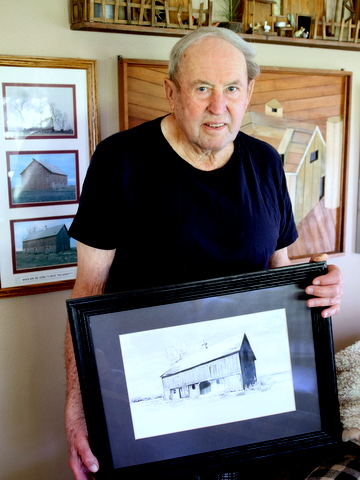
While the demands of farm work limited trips to town, there was fun to be had when it to was time to buy groceries. Bruggeman enjoyed the outdoor movies shown in Lidderdale in the summer months, back when the town had three grocery stories and about as many gas stations. “Dad would give me a nickel so I could get a pop or popcorn,” said Bruggeman, who recalled how cars were lined up on both sides of the town’s busy business district.
Money was hard to come by in those days, and crop yields were nowhere close to what farmers produce today. “When I was a kid, 60 bushels per acre of corn was a really good yield,” said Bill Bruggeman, who started farming full-time in 1955 after completing his military service. As improved corn hybrids become available, Bruggeman won the DEKALB Yieldmasters Club award in 1976 for producing 113.39 bushels of corn per acre.
While much has changed in agriculture since the Bruggemans were raising their four children (including Sheila, Brenda, Cathy and Brett) on the farm, the family is proud to honor the legacy of their Century Farm, which is now owned by Brett Bruggeman.
“It’s wonderful to have a Century Farm,” said Bruggeman, who retired from farming three years ago. “We’re lucky to have one.”
Bruggeman Carroll County Century Farm
• Established: 1903
• Township: Sheridan
• Acres: 120
• Century Farm Award given in 2016
• 4th generation farm
Want more?
Thanks for stopping by. I invite you to read more of my blog posts if you value intriguing Iowa stories and history, along with Iowa food, agriculture updates, recipes and tips to make you a better
If you’re hungry for more stories of Iowa history, check out my top-selling “Culinary History of Iowa: Sweet Corn, Pork Tenderloins, Maid-Rites and More” book from The History Press. Also take a look at my latest book, “Dallas County,” and my “Calhoun County” book from Arcadia Publishing. Both are filled with vintage photos and compelling stories that showcase he history of small-town and rural Iowa. Order your signed copies today! Iowa postcards are available in my online store, too.
If you like what you see and want to be notified when I post new stories, be sure to click on the “subscribe to blog updates/newsletter” button at the top of this page, or click here. Feel free to share this with friends and colleagues who might be interested, too.
Also, if you or someone you know could use my writing services (I’m not only Iowa’s storyteller, but a professionally-trained journalist with 20 years of experience), let’s talk. I work with businesses and organizations within Iowa and across the country to unleash the power of great storytelling to define their brand and connect with their audience through clear, compelling blog posts, articles, news releases, feature stories, newsletter articles, social media, video scripts, and photography. Learn more at www.darcymaulsby.com, or e-mail me at yettergirl@yahoo.com.
Let’s stay in touch. I’m at darcy@darcymaulsby.com, and yettergirl@yahoo.com.
Talk to you soon!
Darcy

What’s the Scoop? Expanded Wells’ Ice Cream Parlor Offers a Taste of Iowa
Love ice cream? Think you can handle something as outrageous as the Monster Peanut Butter Cup Sundae? Then you MUST visit Le Mars, Iowa, soon. Everything is bigger and better at the revamped Wells Visitors Center and Ice Cream Parlor in downtown Le Mars, from the extreme milkshakes and sundaes (Savannah Peach, anyone?) to the spacious parlor itself, where you
can enjoy their sweet treats in the retro-styled dining area or new movie theater upstairs.
“This is a one-of-a-kind experience,” said Adam Baumgartner, vice president of retail sales for Wells Enterprises, Inc., whom I visited with during a recent media day at the ice cream parlor. “Beyond the Iowa State Fair, we want to make this the single-biggest tourist attraction in Iowa.”
More than 200,000 people have visited the parlor each year since it opened in 2011. “Our goal is to more than double that,” said Baumgartner, who noted that the remodeled parlor/visitor center blends education, entertainment and unique experiences for guests of all ages.
In the past year, Wells has invested $3 million in upgrades and expansions for the rebranded facility, which is housed in a historic 1917 building on Central Avenue. Highlights include:
• An interactive “farm to spoon” look at ice cream, from the dairy farm to the grocery store.
• An expanded ice cream menu with more novelties, extreme shakes and desserts, including the Lemon Meringue Shake, Monster Peanut Butter Cup Sundae, Molten Chocolate Lava Shake and more.
• An ice cream cone-shaped display where guests can take fun selfies and share them through text messages and social media.
• A rooftop seating area with views of historic downtown Le Mars.
• Handicap accessibility throughout the building.
• Event center space that can hold up to 200 guests. The space can be rented for parties, meetings and other gatherings.
• The Wells Family Theater, where a short film plays multiple times each hour to tell the story of how Wells and Le Mars came together.
• An engaging Heritage Wall filled with vintage pictures and more to document the unique history of Wells.
• An updated gift shop filled with ice cream-inspired items.
• More space to house all these attractions. The remodeled visitor center/ice cream parlor includes 19,000 square feet, up from 12,000 square feet.

Guests can visit the revamped Wells Visitors Center and Ice Cream Parlor in downtown Le Mars. Members of the Wells team have been welcoming the media and the public to the remodeled facility. Shown here (left to right) are Shannon Rodenburg, Visitor Center marketing and tourism manager; Brenda Phelan, associate manager of food operations: Jean Ann Weiland, associate manager of team operations; Adam Baumgartner, vice president of retail sales; and Brett Susemihl, manager of the Visitor Center and Ice Cream Parlor.
Above all, the parlor reflects Wells’ mission to bring joy to everyday life because of the love of ice cream. “We’re building on a unique family legacy,” Baumgartner said. “We want to put a smile on the face of ice cream lovers for years to come.”
Discover the history of the sweetest place on Earth
All this drives economic development in rural Iowa. Wells employs nearly 3,000 people and produces 150 million gallons of ice cream each year.
“Wells gets all of its fresh dairy from within 75 miles of our production facilities in Le Mars,” said Shannon Rodenburg, marketing and tourism manager for the Wells Visitor Center and Ice Cream Parlor. “Wells collects and processes more than 20 tankers of milk each day, 365 days a year.”
It all began on Oct. 24, 1913, when Fred H. Wells signed a contract with Ray Bowers, a dairy farmer in Le Mars, for “one grey horse, one milk wagon, two barn cans, three 20-quart jars, 60 half-pint jars and the good will of the milk business he has in the city of Le Mars, Iowa,” all for $250. (That’s roughly $6,400 today.) The original contract granted Wells the milk distribution route and guaranteed a source of raw milk from Bower’s herd of 15 cows.
Around 1925, Wells and his sons began manufacturing ice cream in Le Mars. As the popularity of their ice cream grew, they quickly branched out and began distributing their frozen confections in Remsen and Alton, Iowa, the following year. By 1927, Wells and his brother, Harry C. Wells, began a partnership to distribute ice cream in Sioux City.
A big change occurred, however, in 1928, when Fairmont Ice Cream purchased the ice cream distribution system in Sioux City from the Wells brothers, along with the right to use the Wells name. That could have been the end of the ice cream business for Wells, but it wasn’t.
Seven years later, in 1935, the Wells brothers decided to again sell ice cream in Sioux City. No longer able to use the name “Wells,” the brothers decided to run a “Name That Ice Cream” contest in the Sioux City Journal. A Sioux City man, George Vanden Brink, won the $25 cash prize for submitting the winning entry, “Blue Bunny,” after noticing how much his son enjoyed the blue bunnies in a department store window at Easter time. Vanden Brink, who was an illustrator by trade, also created the first Blue Bunny logo, which appeared on Blue Bunny packaging for nearly 70 years.

The revamped Wells Visitors Center and Ice Cream Parlor offers an expanded ice cream menu with more novelties, extreme shakes and desserts, including the Monster Peanut Butter Cup Sundae.
What started as Blue Bunny Ice Cream® has grown to include multiple brands and licensed products today. The company makes nearly 1,000 different products, Baumgartner said.
In fact, there is more ice cream made in Le Mars than in any one location on Earth, making Le Mars the Ice Cream Capital of the World—a title the community has held since Iowa’s state legislature made it official in 1994.
Bringing the ice cream story to life
From a single delivery wagon to the world’s largest family-owned and managed ice cream producer, Wells’ 100+ years in the industry is a pretty sweet story. The company has set its sights on becoming the leading ice cream manufacturer in the nation.
Giving Wells’ ice cream parlor/event center a facelift is part of a bigger goal to make Le Mars a destination, Baumgartner said. “Iowa has a lot of great things to offer. This is a place you have to see. You’ll love it.”
Want more?
Thanks for stopping by. I invite you to read more of my blog posts if you value intriguing Iowa stories and history, along with Iowa food, agriculture updates, recipes and tips to make you a better communicator.
If you’re hungry for more stories of Iowa history, including more stories of Wells and Blue Bunny, check out my top-selling “Culinary History of Iowa: Sweet Corn, Pork Tenderloins, Maid-Rites and More” book from The History Press. Also take a look at my latest book, “Dallas County,” and my Calhoun County” book from Arcadia Publishing. Both are filled with vintage photos and compelling stories that showcase he history of small-town and rural Iowa. Order your signed copies today! Iowa postcards are available in my online store, too.
If you like what you see and want to be notified when I post new stories, be sure to click on the “subscribe to blog updates/newsletter” button at the top of this page, or click here. Feel free to share this with friends and colleagues who might be interested, too.
Also, if you or someone you know could use my writing services (I’m not only Iowa’s storyteller, but a professionally-trained journalist with 20 years of experience), let’s talk. I work with businesses and organizations within Iowa and across the country to unleash the power of great storytelling to define their brand and connect with their audience through clear, compelling blog posts, articles, news releases, feature stories, newsletter articles, social media, video scripts, and photography. Learn more at www.darcymaulsby.com, or e-mail me at yettergirl@yahoo.com.
Let’s stay in touch. I’m at darcy@darcymaulsby.com, and yettergirl@yahoo.com.
Talk to you soon!
Darcy

In the past year, Wells has invested $3 million in upgrades and expansions for the Wells Visitors Center and Ice Cream Parlor in downtown Le Mars. Guests can enjoy their ice cream in the retro-styled dining area or new movie theater upstairs.
@Copyright 2019 Darcy Maulsby & Co. Blog posts may only be reprinted with permission from Darcy Maulsby.

Senator Grassley on Farming: Any Society is Only Nine Meals Away From a Revolution
When people ask about my latest book project and I tell them about Iowa’s Ag History, I get two reactions: either a blank stare, or “Oh cool!” When I reached out to Iowa Senator Charles Grassley, a farmer, to share a few comments for the book, I received more than an enthusiastic response.
I got an incredible interview from a senator who was willing to offer a significant portion of his time to share his insights into the importance of history, agriculture and rural Iowa’s role in the modern global economy. Read on to see why Sen. Grassley says, “I like to remind policymakers that any society is only nine meals away from a revolution.”
When did your family start farming in Iowa?
I am the second generation farmer in my family, following in the footsteps of my father Louis Grassley. His dad emigrated from Germany and died when my dad was just seven years old. At around age 18, my dad started working as a hired hand for the Heitland family on a farm in Hardin County. A few years later, he rented some land near New Hartford in Butler County. In 1927, he and my mother Ruth purchased their own parcel of land.
After graduating from high school, I worked in factories, attended college and farmed with my dad. In 1958, while running for the Iowa legislature and working towards my doctorate at the University of Iowa, I started farming my own piece of the family farm. When my dad passed away in 1960, I rented his 80 acres and about five years later, purchased 120 acres on my own.
When I started out, I grew a bit of everything like most farmers at the time. I grew corn, soybeans, oats and alfalfa and raised sheep, cattle and hogs. My son Robin Grassley, a third-generation farmer, and I continue farming 750 acres together. He rents and owns other farmland along with my grandson Pat Grassley, who is a fourth-generation family farmer.
Barbara and I raised our five children together on our farm near New Hartford, and we enjoy passing on our agrarian heritage and celebrate family gatherings here with our grandchildren and great-grandchildren.
In politics as in farming, a solid understanding of the past is vital to understand current issues. From your unique viewpoint as a senator and a farmer, what’s your take about why it’s important to be well-versed in history–and what are the perils of not knowing history?
As a lifelong farmer who also has worked for six decades representing Iowans in state and federal government, I wear my rural roots as a badge of honor and believe it’s important for farmers to have a seat at the policy-making tables. Farmers take the long view of things, and maybe that’s why they don’t forget important lessons from history.
Only two percent of the American population shoulders the responsibility for growing enough food to feed the U.S. population. Our agrarian-based heritage has experienced rapid transformation in the last generation. Fewer Americans, even in Iowa, have a direct link to living or working on a farm. And most likely due to the affordable abundance of food, not enough people appreciate that food security is directly tied to national security. Food security extends beyond national sovereignty. American agriculture – and the farmers, workers and businesses along the supply chain – anchors the U.S. economy and increasingly strengthens U.S. energy independence, as well.
From a historical perspective, there are two rules of thumb I use to explain how important food security is to maintain peace and prosperity in society. As Emperor of France in the early 19th century, Napoleon Bonaparte reportedly said “to be effective, an army relies on good and plentiful food.” In other words, an army marches on its stomach. Food security ensures a nation can feed its military, whose men and women in uniform are deployed to protect and defend a nation’s sovereignty, at home and abroad. I also like to remind policymakers that any society is only nine meals away from a revolution.
Political leaders who embrace the misguided notion that socialism is the answer to peace and prosperity are either grossly misinformed or willfully ignorant about the peril of leaders who promise to fix “inequality” with government control. Just look at the economic crisis in Venezuela, once one of the most prosperous nations in the Western Hemisphere. The poverty and humanitarian crisis falls squarely in the hands of the nation’s authoritarian regime and its ideologically driven policies. History teaches us that when government suppresses freedom and liberty, the people’s path towards peace and prosperity is replaced with food and medicine shortages, hyperinflation, power outages and even more economic and social inequality.
History teaches us other important lessons. Namely, how not to repeat the mistakes of the past. Don’t forget, the overly harsh tariffs in the Smoot-Hawley Tariff Act of 1932 shut down world trade, led to a worldwide economic depression and foretold a world war that killed tens of millions of people.
Another important lesson I keep in mind at the policy-making tables is the 1980s farm crisis. The loss of thousands of family farms was a heart-wrenching loss for so many families and long-time neighbors across Iowa. It stole a sense of vitality from small towns and rural communities. It arguably steered away a generation of beginning farmers from following in the footsteps of their parents and grandparents. The farm crisis invigorated my advocacy on behalf of young and beginning farmers, including my work to push for robust enforcement of anti-trust laws and oversight of mergers and competition in the agriculture industry. Previously, I’ve introduced legislation that would have amended the Packers and Stockyards Act to make it illegal for a packer to own, feed or control livestock intended for slaughter. I’ll keep my oversight hat on to protect the integrity of the marketplace so that independent producers have a fair shake at a fair price for their commodities.
I also led efforts to enact and make permanent Chapter 12 in the federal bankruptcy code. This unique chapter is designed to help farmers and ranchers who have fallen on hard times to survive bankruptcy and restructure their debts without losing their livelihood. Most recently, I secured an update to Chapter 12 to fix court rulings that undermined congressional intent. Previously, the IRS muscled its way to the front of the creditor’s line to scoop up capital gains taxes and potentially block a farmer’s reorganization plans. Farmers shouldn’t be penalized for being asset-rich and cash-poor. When they need to reorganize debts to hold on to their livelihoods, my reforms ensure they aren’t going to be slapped with a big tax bill and lose the ability to continue farming.
Another way I advocate for family farmers at the policy-making tables is my longstanding efforts to restore fiscal integrity to the farm safety net. In our free market society, farmers ought to be able to decide how large or small they want their operation to be. However, the farm safety net shouldn’t be manipulated for operations to grow at taxpayer expense. It’s very important to uphold the credibility and strengthen the public trust in the farm safety net, as well. That’s why I will continue my efforts to attach reasonable payment limits so that off-site managers, including nieces, nephews, cousins and other family members who aren’t actually contributing to the operation of the farm, are prevented from cashing in on farm payments.
In 2019, I launched my 39th consecutive year holding meetings in each of Iowa’s 99 counties. I keep in close touch with Iowans and count on this dialogue to make representative government work. I also apply the lessons of history to inform my work on making better policies and fixing laws that create unintended consequences. As chairman of the Senate Finance Committee, which has oversight and legislative jurisdiction over international trade, I’m currently working to reform a 1962 federal law that delegated authority to the executive branch. Specifically, Section 232 of the Trade Expansion Act authorizes the president to impose tariffs on selected imports if the chief executive determines those imports pose a threat to our national security.
This law was enacted with good intentions and for good reason. However, history has shown that reforms are necessary in order to give Congress a role in the process. In my view, Congress delegated too much authority to the executive branch at the expense of the people’s branch. American agriculture too often shoulders the burden of retaliatory action from our trade partners. It’s another example of why I always check the rear-view mirror to ensure the road ahead paves the way for prosperity and opportunity for family farmers and all those who earn their livelihoods and enjoy their way of life in Rural America.
What are some of the biggest changes in Iowa agriculture you’ve seen and experienced in your lifetime?
Technology and innovation have revolutionized farming as we know it. Mechanization allows an individual farmer to dramatically improve productivity and harvest bin-busting yields grown from disease-resistant seeds, for example. At the same time, farmers are able to conserve resources and save money using no-till, cover crops and precision agriculture. As a first-generation farmer, my dad used a team of horses when he started farming. Like many family farmers, the genetic code of fiscal discipline, conservation and ingrained work ethic was handed down to me from my parents’ experience carving out a living from the land. In my case, the Grassley household and farming operation was influenced by the Great Depression, to conserve resources and stretch every penny.
To this day, I carry a lifelong code of conservatism with me as a farmer and lawmaker. Although innovation – including WiFi-enabled farms and climate-controlled tractor cabs — hasn’t shortened the work day for most farmers, it’s certainly transformed productivity and changed the way we market our crops and livestock. When I started farming on my own in the 1950s, the average corn yield in Iowa was about 45 bushels/acre. Today Iowa farmers yield an average of 202 bushels/acre. This productivity helps feed and fuel a growing world population with affordable, wholesome food and renewable energy. So increased productivity has been revolutionary.
Another significant change is farmers are affected by worldwide market forces. That means a farmer in the 21st century must be able to survive not just the whims of Mother Nature, but also the winds of geo-political negotiations and foreign policy that impact exports and a farmer’s bottom line.
Ag literacy should be part of education, in my opinion, for any Iowa student. In your opinion, how does a basic understanding of agriculture benefit all Iowans, both rural and urban?
No matter what policy we may be debating in Congress, I often find the best way to sum up the debate boils down to this: Washington is an island surrounded by reality. As a farmer-lawmaker on the Senate Agriculture Committee, I bring a dirt-underneath-my-fingernails perspective to the policy-making tables. I take pride serving as a champion for rural America to advocate for our nation’s food producers and farm families. With only two percent of the population growing food for the rest of the nation, it’s more important than ever to educate consumers about where their food comes from. In fact, I often suggest that many Americans are under the mistaken impression that food grows in grocery stores, restaurants or take-out containers. I’m glad to see more and more farmers’ markets becoming a vital part of local communities. It’s good for the local economy and community vitality and fosters better awareness that food does not grow on the grocery store shelf.
With a global population expected to reach nearly 10 billion people by 2050, the importance of agriculture research and education is vital for human civilization. Iowa’s deeply rooted agrarian heritage continues to lead the way with excellent opportunities to foster ag literacy, food, plant and animal science and entrepreneurship. Iowa boasts a vibrant network of FFA organizations across the state. What’s more, Iowa’s native son Norman Borlaug paved an agricultural revolution credited with saving a billion people from starvation. The Father of the Green Revolution was awarded the Nobel Prize in 1970 and Iowa celebrates his legacy with a statue in the Rotunda of the U.S. Capitol.
Iowa is also home to the World Food Prize. Since 1987 the World Food Prize Foundation has celebrated the achievements of individuals inspired by the legacy of Dr. Borlaug. Each year it awards individuals whose contributions have improved the global food supply, from plant, animal and soil science to technology and nutrition and rural development. For three decades, it has brought thousands of people from around the world to Des Moines in October to talk about food security in a symposium known as the Borlaug Dialogue.
Anything else you’d like to add about the importance of knowing history in general and the history of agriculture in Iowa in particular?
Iowans may know I love history. In today’s polarized world of identity politics, it’s important more than ever to strengthen civic education in America’s classrooms. Our youngest members of society need to understand the perils of communism, fascism and socialism. Regimes inspired by utopian socialist principles do not eradicate hunger or poverty, they extinguish peace and prosperity at the expense of individual freedom and liberty.
Despite the regional, ideological and partisan differences that divide Americans, we share a common humanity and fundamental thread of human existence. We all need to eat to survive. And I’m proud to be among the generations of Iowa farmers who have answered the vocational calling to put food on family tables. As a steward of the soil and U.S. Senator for Iowa, I am honored to serve as a voice for agriculture and rural America.
Want more?
Thanks for stopping by. I invite you to read more of my blog posts if you value intriguing Iowa stories and history, along with Iowa food, agriculture updates, recipes and tips to make you a better communicator.
If you like what you see and want to be notified when I post new stories, be sure to click on the “subscribe to blog updates/newsletter” button at the top of this page, or click here. Feel free to share this with friends and colleagues who might be interested, too.
Also, if you or someone you know could use my writing services (I’m not only Iowa’s storyteller, but a professionally-trained journalist with 20 years of experience), let’s talk. I work with businesses and organizations within Iowa and across the country to unleash the power of great storytelling to define their brand and connect with their audience through clear, compelling blog posts, articles, news releases, feature stories, newsletter articles, social media, video scripts, and photography. Learn more at www.darcymaulsby.com, or e-mail me at yettergirl@yahoo.com.
If you’re hungry for more stories of Iowa history, check out my top-selling “Culinary History of Iowa: Sweet Corn, Pork Tenderloins, Maid-Rites and More” book from The History Press. Also take a look at my latest book, “Dallas County,” and my Calhoun County” book from Arcadia Publishing. Both are filled with vintage photos and compelling stories that showcase he history of small-town and rural Iowa. Order your signed copies today! Iowa postcards are available in my online store, too.
Let’s stay in touch. I’m at darcy@darcymaulsby.com, and yettergirl@yahoo.com.
Talk to you soon!
Darcy
@Copyright 2019 Darcy Maulsby & Co. Blog posts may only be reprinted with permission from Darcy Maulsby.
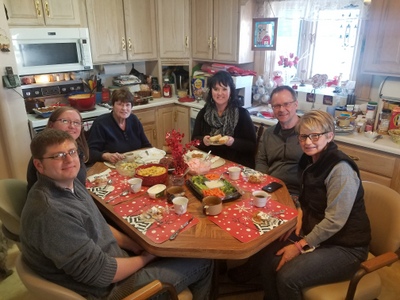
From My Kitchen to Yours: Comfort Food, Conversation and Living History Farms
Ever get an email that jumps out at you? It happened me to last July when one arrived with the subject line “Greetings from Living History Farms.” It was from my friend, Jim Dietz-Kilen, a former classmate from the Ag-Urban Leadership Initiative, and his note intrigued me.
“I have an idea for your consideration,” wrote Jim, who is the vice president of development for Living History Farms (LHF). “We are planning our annual gala, Farmstasia. We try to put together unique experience packages for our auction, with emphasis on agriculture/rural life and Iowa history. My idea is to build a package around you. While I am very open to other ideas, I wanted to run the following request by you:
• Would you be willing to donate a signed book? Any of your books would be wonderful, but I am partial to the Culinary History of Iowa.
• Would you also be willing to host a family at your farm to show them a bit of what your lives are like?
• Finally, would you be willing to serve these guests a meal selected from your book?
I know this is asking a lot, Darcy, but I have learned that you never know until you ask. And, as Wayne Gretzky said, ‘Every shot you don’t take is a miss.'”
By this point, I was already brainstorming menu ideas.
I’m a big fan of LHF, which welcomes between 100,000 and 110,000 each year. This interactive, 500-acre outdoor museum that tells the amazing 300+ year story of how Iowans transformed the fertile prairies of the Midwest into the most productive farmland in the world. As I wrote in this blog for Latham Hi-Tech Seeds, I love how LHF encourages people of all ages to explore Iowa’s rural heritage, including the 1700 Ioway village, the 1850 pioneer farm, the 1875 town of Walnut Hill and the 1900 horse-powered farm.
“All proceeds from Farmstasia go to keep fees low for our education programs, helping make it possible for kids from across the state to come here for school visits and participate in other educational experiences,” Jim continued.
Jim knows what is near and dear to my heart. Iowa agriculture. Books. Classic Iowa farm cooking. LHF. Giving back to the community. Without hesitating, I said yes.

Living History Farms Iowa
Cookstoves, corncobs and storytelling
LHF came into my life in a big way in the summer of 1995, when my college internship led me to the 1900 farm, Flynn mansion and veterinary clinic, where I served as a historical interpreter and looked the part in my Victorian-inspired dresses and bonnets.
That summer changed my life in so many ways. I met my husband through this experience. I also expanded my cooking skills. By the end of the summer, I knew how to light a cookstove with crumpled newspapers and corncobs. I could make homemade noodles with no problem. I could bake cookies in an oven with no temperature gauge, other than the feel of the heat on your hand. I could milk a Jersey cow by hand and churn the cream into butter. I could plan a meal and feed a threshing crew. I could even run a treadle sewing machine and sew my own apron.
Looking back, I was a prepper in training who can live off the grid if I have to.
While I don’t use all those skills today, some have served me well for years, especially the cooking skills, the historical knowledge I gained and the storytelling skills I learned. As a historical interpreter, I was not only working in the kitchen of the 1900 farm fixing a meal, but I interacted with guests. As I shared stories about Iowa farm life in the early 1900s, I learned the importance of listening. I’m still embarrassed when I misunderstood one guest who asked, “Is that a coal stove?” but I heard him say, “Is that a cold stove?” so I replied, “No, it’s a warm one!”
Planning a memorable menu
I was thinking of those experiences last Saturday, February 16, when I delivered on my promise to provide the Farmtasia winning bidders with an authentic Iowa farm meal inspired by my book. I had actually started cooking the night before and then got up early on Saturday morning so I’d get everything done on schedule and have time to visit with my guests.
They pulled in the driveway at my family’s Century Farm near Lake City right on time. It was an honor to host Dave Bubeck, a corn breeder at Corteva Agriscience™ in Johnston; his wife, Denise; and their friends Ben and Michelle Parlett, who also live in the Des Moines area. As we gathered around the table at noon, I served:
• Garden Vegetable Soup
• Homemade Beer Bread
• Iowa Ham Balls
• Glazed Meat Loaf
• Garlic Cheesy Smashed Potatoes
• Relish tray and coleslaw salad
• Homemade apple crisp with Haralson apples grown on our farm
There was something magical happened as we sat in that 100+plus-year-old kitchen, talking farming, food, travel and LHF. Seems like we covered everything, from how to talk about GMOs to what it’s like subscribing to a meal delivery service. Two and a half hours later, when my guests departed, we all agreed it was a great experience—the kind of story-worthy experience that LHF inspires. Even better, we’re staying in touch through social media and my e-newsletter.
And to think it all started with a simple email and a spirit of service. It reminds me of this quote from Orison Swett Marden, who founded SUCCESS magazine in 1897.
“We must give more in order to get more. It is the generous giving of ourselves that produces the generous harvest.”
Let’s get cooking
If you’d like to create a taste of our classic Iowa farm dinner, here are some of my favorite recipes:

Hearty Homemade Vegetable Soup
Hearty Garden Vegetable Soup
I shared this tasty recipe in one my my monthly diary entries in 2018 for the Iowa Food and Family Project.
1 tablespoon olive oil
8 medium carrots, sliced
3 large onions, chopped
5 celery ribs, chopped
1 large green pepper, seeded and chopped
1 garlic clove, minced
2 cups chopped cabbage
2 cups frozen cut green beans (about 8 ounces)
2 cups frozen peas (about 8 ounces)
1 can (15 ounces) corn, or 2 cups fresh sweet corn
1 can (28 ounces) diced tomatoes, undrained
2 bay leaves
2 teaspoons chicken bouillon granules
1-1/2 teaspoons dried parsley flakes
1 tablespoon seasoning salt
1 teaspoon dried marjoram
1 teaspoon dried thyme
1/2 teaspoon dried basil
1/2 teaspoon pepper
7 cups water
1 teaspoon Worcestershire sauce
4 cups V8 vegetable juice
In a stockpot, heat oil over medium-high heat; sauté carrots, onions, celery and green pepper until crisp-tender. Add garlic; cook and stir 1 minute. Stir in remaining ingredients; bring to a boil. Reduce heat; simmer, covered, until vegetables are tender, 1 to 1-1/2 hours. Remove bay leaves.
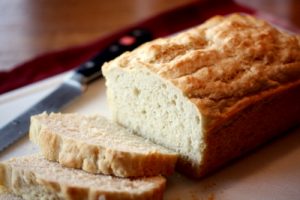
Best Beer Bread
Best Beer Bread
2 cups self-rising flour
2 1 / 2 tablespoons sugar
1 12-ounce can of beer
Mix all ingredients together. Pour batter into a greased loaf pan. Bake at 350 degrees for 45 to 50 minutes.

Iowa Ham Balls
Iowa Ham Balls
This tasty, classic recipe comes from my friend Val Plagge, who is a wonderful farm cook.
2.5 pounds ham
2 eggs
1 1/2 cups graham cracker crumbs
1 cup milk
1 can tomato soup
3/4 cup brown sugar
1/4 cup white vinegar
1 teaspoon ground mustard
With a food processor, grind ham into small, chopped pieces (or buy ham loaf mix from local grocery store or butcher. This mix usually contains ham and ground pork, and sometimes ground beef, too). Add eggs, graham cracker crumbs and milk. Mix together with your hands, and form fist-sized ham balls. (If the mixture seems a little dry, add 1/4 cup of milk at a time, up to 1 1/2 cups of milk total.) Place ham balls in a greased 9-inch by 13-inch pan. They fit nicely three across and five down.
Mix soup, brown sugar, vinegar and mustard until smooth. Drizzle glaze over the ham balls for the classic ham ball sauce. (Or, if you’re in a rush, drizzle your favorite barbecue sauce over the ham balls.) Bake at 350 Fahrenheit for 1 hour. Yield: 13-15 ham balls
Note: These ham balls freeze well and can be warmed up in a slow cooker, if desired. Ham balls are the perfect Iowa potluck treat!
Cheesy Garlic Mashers
Taking a twist on classic mashed potatoes, this recipe is loaded with flavor and offers the perfect comfort food.
Red Bliss or Yukon gold potatoes (use about one potato per person, although this will depend on the size of the potatoes)
6 garlic cloves (can use less, if you prefer)
Butter, 1 / 2 stick
Cream (use enough to give mashed potatoes the consistency you prefer)
1 carton sour cream (can substitute one carton of chip dip, if you prefer)
1 / 2 cup to 1 cup of Cheddar cheese
Seasoning salt and pepper, to taste
Chives, chopped
Bacon, 2 to 3 slices, fried
Boil potatoes in salted water with peeled, whole garlic cloves. When potatoes are done cooking, drain potatoes and garlic and place in a bowl with butter and cream. Mash together. Add more cream, if necessary, to achieve the consistency you prefer. Mix in sour cream and cheddar cheese. Season to taste with seasoning salt and pepper. Garnish with chopped chives and real bacon bits.
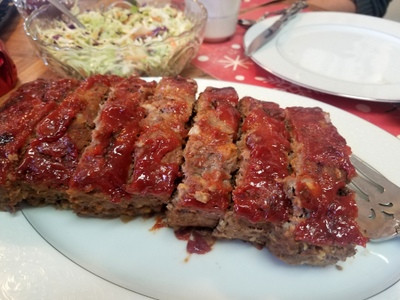
Glazed Meatloaf
Darcy’s Best Brown-Sugar Meatloaf
This recipe was inspired by the meatloaf that caterers prepared on the set in Iowa for the filming for “The Bridges of Madison County.” This is the only meatloaf recipe you’ll ever need!
1 pound ground beef
1 pound ground pork or ground turkey
1 cup herb-seasoned stuffing mix
1 onion, chopped
1 teaspoon salt
1/2 teaspoon freshly-ground pepper
1 teaspoon nutmeg
2 large eggs, lightly beaten
3 / 4 cup milk
2 tablespoons barbecue sauce
1 / 4 cup ketchup
2 tablespoons brown sugar
1 teaspoon dry mustard
Combine beef, pork or turkey, stuffing mix, onion, salt, pepper and nutmeg. In a separate bowl, beat eggs, milk, and barbecue sauce. Add to meat mixture, mixing well. Press into a meatloaf pan sprayed with non-stick cooking spray.
Combine ketchup, brown sugar, and mustard; spread over top of meat loaf. Bake, uncovered, at 350 degrees F for 1 hour and 30 minutes or until a thermometer inserted in the center of the loaf registers 160 degrees. Yield: 6 servings
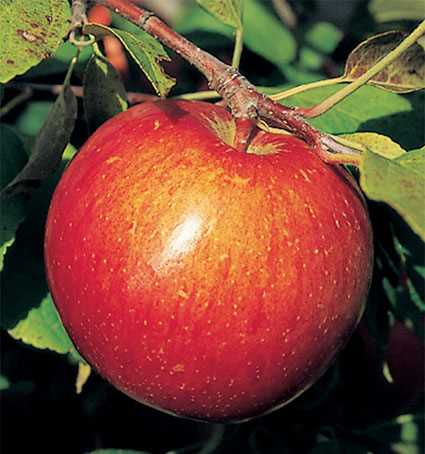
Haralson apple photo from Jung Seed
Farm-Fresh Apple Crisp with Whipped Cream
If you have the chance to visit a local apple orchard, pick up some Haralson apples, if they are available. We grow Haralsons on our farm, and their sweet-tart flavor works perfectly in apple pies and apple crisps.
Fruit Filling:
6 baking apples, peeled, cored and cut into wedges
1 tablespoon lemon juice
1 / 2 cup sugar
2 tablespoons flour (maybe need more, depending on how juicy the apples are)
Crumb topping:
1 1 / 4 cups flour
1 / 2 cup rolled oats
1 / 2 cup light brown sugar
1 / 2 teaspoon ground cinnamon
1 / 4 teaspoon salt
12 tablespoons butter (1 1/2 sticks), cut into small pieces
Preheat the oven to 350 degrees Fahrenheit.
For the fruit filling:
In a large mixing bowl, toss together the apples, lemon juice, sugar, and flour. Pour the apple mixture into a buttered 2-quart baking dish and set aside.
For the topping:
In a large mixing bowl, mix the flour, rolled oats, brown sugar, cinnamon, and salt. With a pastry blender, work the butter into the flour mixture just until mixture comes together and pea-sized clumps form.
Sprinkle the topping evenly over the fruit. Bake the apple crisp until the fruit is bubbling and the topping is golden brown and crisp, about 45 minutes.
Serve the crisp warm with vanilla bean ice cream or fresh whipped cream, if desired.
To make whipped cream, pour 1 cup of whipping cream into metal bowl on stand mixer. (Chill the bowl and whip attachment in the refrigerator first.) Begin mixing on high speed. As the cream starts to form into whipped cream, add powdered sugar a tablespoon at a time, until you achieve the sweetness you desire. Continue mixing on high until the mixture looks like thick whipped cream. Serve with apple crisp.
Want more?
Thanks for stopping by. I invite you to read more of my blog posts if you value intriguing Iowa stories and history, along with Iowa food, agriculture updates, recipes and tips to make you a better communicator.
If you like what you see and want to be notified when I post new stories, be sure to click on the “subscribe to blog updates/newsletter” button at the top of this page, or click here. Feel free to share this with friends and colleagues who might be interested, too.
Also, if you or someone you know could use my writing services (I’m not only Iowa’s storyteller, but a professionally-trained journalist with 20 years of experience), let’s talk. I work with businesses and organizations within Iowa and across the country to unleash the power of great storytelling to define their brand and connect with their audience through clear, compelling blog posts, articles, news releases, feature stories, newsletter articles, social media, video scripts, and photography. Learn more at www.darcymaulsby.com, or e-mail me at yettergirl@yahoo.com.
If you’re hungry for more stories of Iowa history, check out my top-selling “Culinary History of Iowa: Sweet Corn, Pork Tenderloins, Maid-Rites and More” book from The History Press. Also take a look at my latest book, “Dallas County,” and my Calhoun County” book from Arcadia Publishing. Both are filled with vintage photos and compelling stories that showcase he history of small-town and rural Iowa. Order your signed copies today! Iowa postcards are available in my online store, too.
Let’s stay in touch. I’m at darcy@darcymaulsby.com, and yettergirl@yahoo.com.
Talk to you soon!
Darcy
@Copyright 2019 Darcy Maulsby & Co. Blog posts may only be reprinted with permission from Darcy Maulsby.
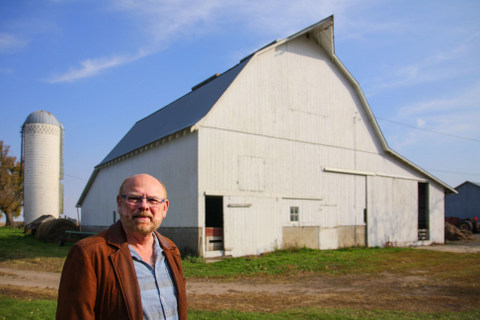
Barn Helped Inspire Master Craftsman to Create Dobson Pipe Organ Builders
When a sow kicked a heat lamp into the straw one cold January night in 1954 and burned down the barn on the Carroll County farm where Lynn Dobson’s family lived, no one imagined how much impact the blaze would have. It became a defining moment for Dobson, however, even though he was only four years old at the time.
“When the barn was rebuilt that summer, I wanted to be out working with the carpenters all the time,” said Dobson, founder of Dobson Pipe Organ Builders Ltd. of Lake City, which constructs fine pipe organs for churches, universities and other clients. “The carpenters told my mom they didn’t mind, and they even gave me small tools to ‘work’ with, including a hammer and screwdriver.”
Once the Wilson brothers from Farnhamville completed the new barn, they were hired each summer to work on other construction and remodeling jobs for various outbuildings at the Jasper Township farm. “These construction projects were a highlight of growing up on the farm,” said Dobson, who also learned carpentry skills from his father, Elmer, who was a cabinetmaker as well as a farmer. “My imagination was fired up.”
“They feel like cathedrals”
Dobson admits he enjoyed building things much more than farming. That didn’t mean he didn’t have his share of chores to do on the farm, however. His father liked raising livestock, so there were usually eight to 10 milk cows to care for, along with feeder calves, hogs and chickens. In fact, the barn was built for milk cows, said Dobson, who noted that Bill Troxel from Lanesboro picked up milk from the farm.
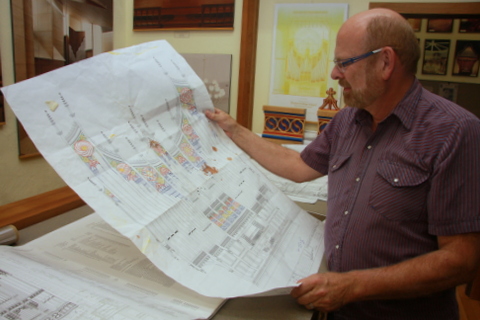
Lynn Dobson designs grand pipe organs that grace churches in small towns like Lake City, Iowa, to cathedrals in New York City.
The barn also housed stock cattle. Dobson will never forget the little bull calf that had to be bucket fed after its mother died. “He had always been so gentle, but one night he decided to pin me against the barn. His horns pushed into the wall and his head was right against me. I never had to feed him again after that.”
Other activities inside the barn were much less threatening. Dobson enjoyed playing in the barn with his sisters and building forts in the straw bales. Sometimes he climbed the ladder that extended to the peak of the roof. “I’d catch little pigeons and try to tame them and raise them as pets,” he said.
The barn was always a hub of activity, Dobson added. While Elmer Dobson phased out of the dairy business in the early 1960s, he continued raising hogs and farrowed sows in the barn. He maintained his livestock operation for many years until he and his wife, Muriel, retired and moved to Lake City in the early 1980s.
After Dobson graduated from Glidden High School in 1967, he studied art at Wayne State College in Nebraska, where he earned his undergraduate degree in 1971. In 1974, he established Dobson Pipe Organ Builders, which recently designed, built and installed a customized pipe organ for the 2014 observance of the 750th anniversary of the founding of Merton College at Oxford, the oldest university in the English-speaking world.
In a way, the inspiration to create this massive organ, known as Opus 91, can be traced to the Carroll County barn that captured Dobson’s interest as a boy. “Barns are grand buildings, and I’m inspired by their magnificent spaces,” he said. “They feel like cathedrals inside.”
Pipe organ builder hits a high note
Note from Darcy: I wrote this feature below on Dobson Pipe Organ builders in 2013.
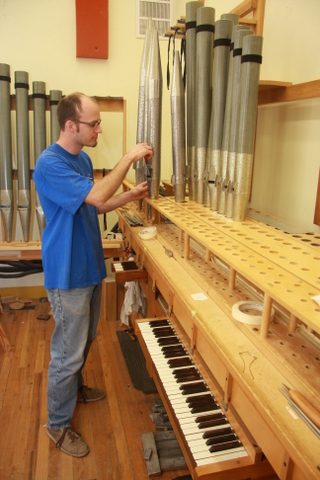
Donald Hobbs, a long-time employee at Dobson Pipe Organ Builders in Lake City, helps create the masterpieces that the company builds for clients worldwide.
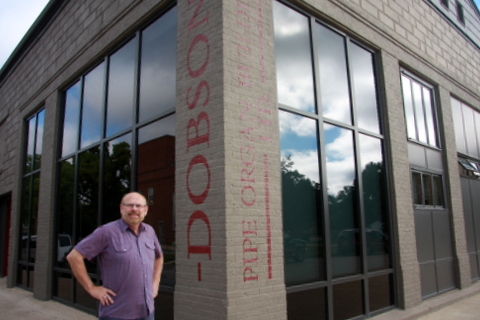
A former John Deere shop has housed Dobson PIpe Organ Builders for years in Lake City, Iowa.
The journey that started on a farm near Lake City has taken an Iowa pipe-organ company international, thanks to the creative vision and entrepreneurial skills of Lynn Dobson.
Dobson Pipe Organ Builders Ltd. designed, built and installed a customized pipe organ for the 2014 observance of the 750th anniversary of the founding of Merton College at Oxford, the oldest university in the English-speaking world. “It’s very unusual for American organ builders to send organs to Europe,” said Dobson, who noted that construction on the organ started in 2011. “It hardly ever happens.”
Made of quarter-sawn white oak from the southern United States, this masterpiece (known as Opus 91) rises 46 feet tall, stretches 26 feet wide, weighs about 16 tons and features hand-carved designs. It also contains nearly 3,000 pipes, which range in size from a drinking straw to a telephone pole.
Opus 91 is a 52-rank mechanical key action organ, which means that there are mechanical links that directly connect each of the keys to valves under the pipes. This kind of organ was created before the advent of electricity and generally is preferred among premier organists.
While this is Dobson Organ’s first overseas project, the company had built 90 organs since 1974 before creating “Opus 91” for Merton College. “We’ve never built the same organ twice,” said Dobson, the company’s president and artistic director.
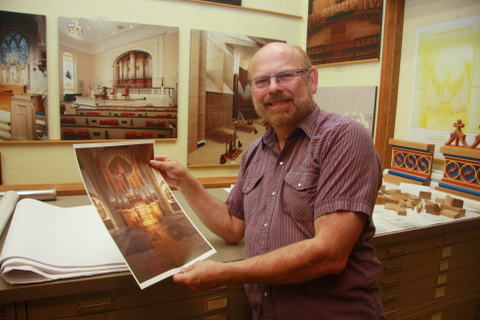 Organ building, like many centuries-old crafts, is becoming increasingly rare. Companies like Dobson’s are even fewer, with an estimated half dozen nationwide. As I look back at the last 40 years of my life, organ building was a good career for me. It gave me a chance to be creative and work with many creative people over the years. I’ve also had the chance to travel and see and do an almost unimaginable variety of things that I realize have made my life a very satisfying one. Dobson grew up on a farm south of Lake City, where he learned about woodworking from his father, a skilled carpenter and cabinetmaker. While attending Nebraska’s Wayne State College, studying art and industrial education, Dobson tinkered with an old, non-working pipe organ in the college administration building. By the time he left, it was playable.
Organ building, like many centuries-old crafts, is becoming increasingly rare. Companies like Dobson’s are even fewer, with an estimated half dozen nationwide. As I look back at the last 40 years of my life, organ building was a good career for me. It gave me a chance to be creative and work with many creative people over the years. I’ve also had the chance to travel and see and do an almost unimaginable variety of things that I realize have made my life a very satisfying one. Dobson grew up on a farm south of Lake City, where he learned about woodworking from his father, a skilled carpenter and cabinetmaker. While attending Nebraska’s Wayne State College, studying art and industrial education, Dobson tinkered with an old, non-working pipe organ in the college administration building. By the time he left, it was playable.
This inspired him to start his own company, which started as a two-man operation and has grown to include 19 skilled employees. They include voicers, pipe makers, cabinetmakers and general organ builders who work in a 1890s-vintage shop located on Lake City’s city square. The company has built about 20 new organs for customers in Iowa, including the Lake City Union Church, Westminster Presbyterian Church in Des Moines and the First Reformed Church in Orange City. The firm has restored an additional 20 organs across Iowa.
Dobson’s reputation has also earned the company acclaim across the United States. Some of the company’s largest projects include the organs at the Cathedral of Our Lady of the Angels in Los Angeles, the Kimmel Center for the Performing Arts in Philadelphia and St Thomas’ Church, New York City.
“I think every day is more exciting,” Dobson said. Even though the economy and a changing cultural and religious climate are great challenges for us in the organ building field the fact is we’re still able to be creative and work with good people. What could be better than that?
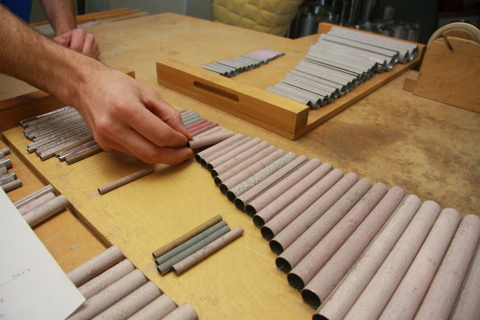
Dobson organ pipes can be as tiny as a pencil to produce the higher notes, and up to 40 feet tall (with pipes weighing 500 pounds) to produce the low notes. Pipes can be made of metal or wood. As shown here, the pipes’ coating, which keeps the solder on the seams, is washed off to expose the shiny pipes once the process is complete.
Want more?
Thanks for stopping by. I invite you to read more of my blog posts if you value intriguing Iowa stories and history, along with Iowa food, agriculture updates, recipes and tips to make you a better communicator.
If you like what you see and want to be notified when I post new stories, be sure to click on the “subscribe to blog updates/newsletter” button at the top of this page, or click here. Feel free to share this with friends and colleagues who might be interested, too.
Also, if you or someone you know could use my writing services (I’m not only Iowa’s storyteller, but a professionally-trained journalist with 20 years of experience), let’s talk. I work with businesses and organizations within Iowa and across the country to unleash the power of great storytelling to define their brand and connect with their audience through clear, compelling blog posts, articles, news releases, feature stories, newsletter articles, social media, video scripts, and photography. Learn more at www.darcymaulsby.com, or e-mail me at yettergirl@yahoo.com.
If you’re hungry for more stories of Iowa history, check out my top-selling “Culinary History of Iowa: Sweet Corn, Pork Tenderloins, Maid-Rites and More” book from The History Press. Also take a look at my latest book, “Dallas County,” and my Calhoun County” book from Arcadia Publishing. Both are filled with vintage photos and compelling stories that showcase he history of small-town and rural Iowa. Order your signed copies today! Iowa postcards are available in my online store, too.
Let’s stay in touch. I’m at darcy@darcymaulsby.com, and yettergirl@yahoo.com.
Talk to you soon!
Darcy
@Copyright 2018 Darcy Maulsby & Co. Blog posts may only be reprinted with permission from Darcy Maulsby.
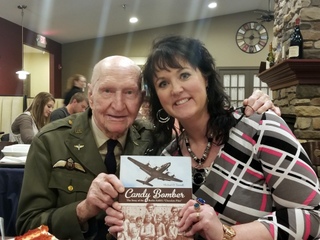
Unwrapping Storytelling Tips from the Candy Bomber
It was a typical evening in Denison, Iowa, when I stopped by the Hillside Grille Steakhouse, but I wasn’t there for the food, and this was no ordinary gathering. I had been invited to meet an authentic American hero, but I was afraid he’d be tired.
Col. Gail Halvorsen, 97, had flown into the Omaha airport on May 2, 2018, with his daughter late that afternoon from his home in the western United States. Turns out I didn’t need to worry about the energy level of this famed World War 2-era pilot. As soon as I sat down at the table near him at the Hillside Grille around 7:45 p.m., the “Candy Bomber” flashed me a big smile.
I knew this was going to be good. I had known it a few days earlier when my friend Vance Lundell, owner of Lundell Plastics in Odebolt, mentioned that the Candy Bomber was coming to western Iowa and invited me to meet the legendary pilot.
To understand the Candy Bomber’s story, let’s go back to 1948. World War 2 was over, but the war’s aftermath continued to ravage Europe. Life was especially grim in Berlin, Germany, which had become a divided city within a divided country.
The Soviets were attempting to cut off Western access to West Berlin, which was located deep inside Soviet-controlled East Germany. Soviet leader Josef Stalin blockaded all ground routes coming in and out of Berlin to cut off West Berliners from all food and other essential supplies. The blockade against the Western Allies threatened to crush a city that was already struggling against starvation. Without outside help, more than 2 million people might die.
In response, the United States and the United Kingdom launched the Berlin Airlift, a humanitarian rescue mission to airdrop food into West Berlin. Halvorsen was part of this effort. Not only did he help provide nourishment to the people of West Berlin, but he also gave the children a reason to hope for a better world—and it also started with two sticks of gum.
Halvorsen, like scores of other Western pilots, had been working 12 to 15 hours a day to deliver food and supplies at Berlin’s Tempelhof Airfield (which is now a public park) like clockwork. But only Halvorsen had an unlikely inspiration that would end up making him famous.
When he encountered some German children lingering at the edge of the air field, he offered two sticks of Wrigley’s chewing gum before departing. When he saw the excitement this small offering generated, the pilot promised to drop candy on his next flight.
When the children asked how they would know which of the huge airplanes was his, Halvorsen said he would wiggle his wings as he approached their position. “Uncle Wiggly Wings” was born.
Halvorsen lived up to his promise and inspired other pilots to donate their candy rations. Halvorsen started dropping chocolate, gum drops and other candy out his plane’s window as a treat for the emaciated Berlin kids often huddled together on the edge of the airfield. He even used spare handkerchiefs to rig up a little parachute for each load so the candy wouldn’t be squashed upon impact. “Operation Vittles” evolved into “Operation Little Vittles” as the Candy Bomber delivered candy and good cheer to the children of the blockaded city.
After newspapers got wind of what was happening, tons of donations of chocolate and other candy donations began pouring in from across America. Halvorsen had not only put a face on the Berlin Airlift, but he bolstered the U.S.’s humanitarian mission during the Cold War by enlisting the American public.
This was no small miracle, considering that Americans who had grown weary of continued food aid for Europe eagerly embraced the opportunity to give candy and chocolate to German children.
From one thoughtful, generous act came a lifelong friendship between the Candy Bomber and the children of Berlin. Halvorsen’s remarkable story is preserved in a number of books, including “Mercedes and the Chocolate Pilot,” a children’s book that tells the true story of a seven-year-old girl named Mercedes who lived in West Berlin during the airlift and still stays in touch with the Candy Bomber.
In fact, the Candy Bomber has been preparing to return to Germany this June for another visit with friends he made all those years ago. Maybe I shouldn’t have been surprised. Nothing seems to slow Halvorsen down—at least not for long. An hour and a half after I had arrived to meet him at the restaurant in Denison a few weeks ago, Halvorsen showed no signs of fatigue, even though it was well past 9 p.m., and he’d been busy giving media interviews and meeting new friends that evening.
When I asked Halvorsen how he was doing, his reply “I’m ready to go!” wasn’t a plea. It was a confident, spirited answer conveying his zest for life and his love of adventure. His Iowa adventure continue the next morning when he spoke to students at the school in Odebolt before flying home.
I admit—I’ve been a little surprised to learn that many Iowans aren’t familiar with the Candy Bomber, even though his story has been shared widely. I asked Halvorsen his thoughts on the importance of teaching history. “It’s important to remember, isn’t it? Thanks for teaching the youth.”
I want younger generations to know that thanks to Halvorsen’s efforts and those of his fellow pilots, the Allies held on to West Berlin and maintained support back home for the Berlin Airlift. By 1949, the Soviets lifted the blockade, and land delivery of food resumed.
It’s not just important, but essential, to share the stories of leaders like Halvorsen who prove how one person can make a positive difference and change the course of history. You just never know how much impact your story can have, not just now, but for generations to come. I’ll never forget one final insight my new friend, the Candy Bomber, shared that night in Denison. “The small things you do can turn into great things.”
Want more?
Thanks for stopping by. I invite you to read more of my blog posts if you value intriguing Iowa stories and history, along with Iowa food, agriculture updates, recipes and tips to make you a better communicator.
If you like what you see and want to be notified when I post new stories, be sure to click on the “subscribe to blog updates/newsletter” button at the top of this page, or click here. Feel free to share this with friends and colleagues who might be interested, too.
Also, if you or someone you know could use my writing services (I’m not only Iowa’s storyteller, but a professionally-trained journalist with 20 years of experience), let’s talk. I work with businesses and organizations within Iowa and across the country to unleash the power of great storytelling to define their brand and connect with their audience through clear, compelling blog posts, articles, news releases, feature stories, newsletter articles, social media, video scripts, and photography. Learn more at www.darcymaulsby.com, or e-mail me at yettergirl@yahoo.com.
If you’re hungry for more stories of Iowa history, check out my top-selling “Culinary History of Iowa: Sweet Corn, Pork Tenderloins, Maid-Rites and More” book from The History Press. Also take a look at my latest book, “Dallas County,” and my Calhoun County” book from Arcadia Publishing. Both are filled with vintage photos and compelling stories that showcase he history of small-town and rural Iowa. Order your signed copies today! Iowa postcards are available in my online store, too.
Let’s stay in touch. I’m at darcy@darcymaulsby.com, and yettergirl@yahoo.com.
Talk to you soon!
Darcy
@Copyright 2018 Darcy Maulsby & Co. Blog posts may only be reprinted with permission from Darcy Maulsby.
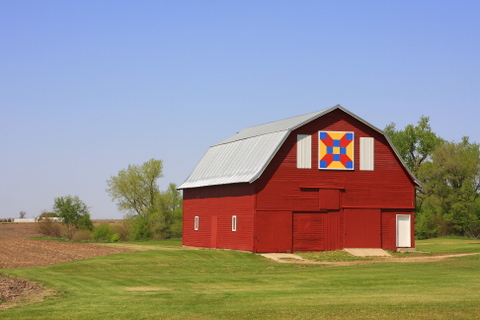
Pieced Together: Barn Quilt Documentary Features Iowa Stories
Barn quilts have become a folk-art phenomenon in Iowa in the past 15 years, turning up not only on barns, but mailboxes, gardens, buildings in town and more. But there was a time not that long ago when no one had ever heard of a barn quilt—not until Donna Sue Groves wanted to add a little color to her corner of the world.
Her story—and those of barn quilt enthusiasts in places like Sac County—inspired the 53-minute documentary “Pieced Together,” which filmmaker Julianne Donofrio showed in Sac City to a full house at the First Christian Church on the evening of Sept. 24, 2018.
“A lot of people don’t know where barn quilts came from,” said Donofrio, who is from the New York City/Washington, D.C. area. “I want people to know Donna Sue’s story.”
The story, which includes many barn quilts across Iowa, began in 1989 when Groves’ family bought a farm in Adams County, Ohio, near the Ohio River Valley at the foothills of the Appalachian Mountains. Groves made a casual remark to her mother, Nina Maxine Groves, about an uninspiring, time-worn tobacco barn on the farm.
“It was the ugliest barn I’d ever seen,” Groves said in “Pieced Together.” “I joked to my mother, ‘I’ll paint you a quilt square on it someday.’”
Game inspires a lifelong love of barns
Groves’ interest in barns dates back to her childhood. When her family would visit Groves’ grandmother in Roane County, West Virginia, Groves’ mother invented a car game to keep Groves and her brother quiet.
“You couldn’t play the typical license plate game when you’re traveling the back roads of West Virginia, because all you saw were West Virginia license plates,” Groves said. “Mother created a car game where we counted barns.”
Some barns were worth two points, while others were worth three points. If a barn had outdoor advertising, like “Chew Mail Pouch” or “RC Cola,” players got a 10-point bonus if they could read the lettering. Red barns also earned higher points. The chance to earn even more points awaited when the family’s wider travels took them past Pennsylvania Dutch barns with colorful, geometric hex signs.
The game led to discussions and questions about the barns, such as who built the barns, and for what purpose. Groves enjoyed these conversational teaching moments. “I looked forward to seeing barns,” she said.
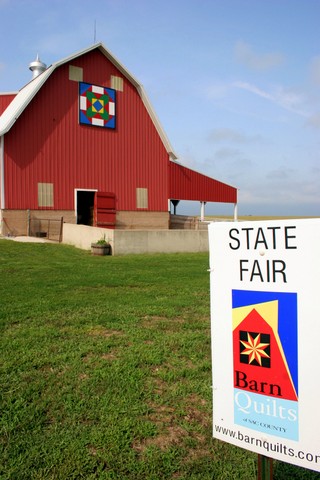
Sac County Iowa barn quilt
Creating a clothesline of quilts across America
This history eventually inspired Groves’ involvement with the first barn quilt square, an Ohio Star pattern, which was created in October 2001 and displayed in Adams County, Ohio. This small gesture triggered a ripple effect across North America.
“If we didn’t pick up on this idea, someone else would,” said Groves’ mother, Maxine, who was featured in “Pieced Together.”
As more people wanted to create barn quilts, Groves and her fellow volunteers quickly learned that painting barn quilts directly onto barns didn’t work too well, but painted plywood squares offered a much better option.
Why stop with just a few barn quilts, though? “A trail of barn quilts could bring tourists here to see all the wonderful things Adams County offers,” noted Groves, who has served as a field representative for the Ohio Arts Council. “Then they’d stay in our bed-and-breakfasts and motels and eat at our restaurants.”
These opportunities for economic development, combined with the visual appeal of barn quilts, soon inspired a “clothesline of quilts” across America. Residents of an adjoining county, Brown County, Ohio, loved Groves’ idea and asked how to get involved. Folks in Tennessee read an article about the Ohio barn quilt project, called Groves and wanted to know how to do a similar project in their area. Grundy County, Iowa, also got involved in 2003, followed by Sac County.
When Sue Peyton and her family from rural Sac City heard about barn quilts, it seemed like a good fit for her son, Kevin, who was in high school and looking for a project he could use as a 4-H leadership project and a Herbert Hoover Uncommon Student Award project.
“I immediately fell in love with the project when I heard about it,” Sue Peyton said. “Barns and barn quilts are such a natural fit.”
The Peytons coordinated the construction and painting of Sac County’s first barn quilts in the summer of 2005. While some people weren’t quite sure what to make of the new barn quilts that started appearing on barns and corncribs around the county, the concept caught on quickly. “We hoped to get 20 barn quilts,” said Sue Peyton, who added that Sac County boasted 55 barn quilts within two years of the start of the project.
“I’ve seen a lot of quilt trails, and you embraced this early on and have done a tremendous job,” said Donofrio as she chatted with audience members in Sac City following her documentary.
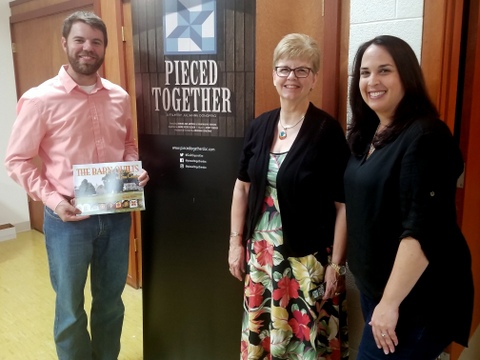
Sac County barn quilt proponents Kevin Peyton and his mother, Sue, (center) welcomed filmmaker Julianne Donofrio, who showed her 53-minute documentary “Pieced Together” in Sac City to a full house at the First Christian Church in September 2018.
“We’re here to stay”
Anywhere there’s a barn quilt trail, every square tells a story. Also, there’s no right or wrong way to create a barn quilt. “Barn quilts have a storied history as complex and diverse as the quilt patterns themselves,” Kevin Peyton said.
Consider the Double Aster barn quilt pattern on the Hogue family’s 1943 barn north of Odebolt. The pastel-colored design complements the family’s Prairie Pedlar Gardens business. Owner Jane Hogue, who served on the original Sac County Barn Quilt Committee, enjoyed watching the “Pieced Together” documentary.
“It was fun to see the snippets of Sac County’s barn quilts in the film,” she said. “We’re proud to be part of Sac County’s barn quilt project. With our gardens and tourism, it’s a win-win.”
Sac County proves that barn quilts offer an effective way to help save barns, promote rural tourism and boost economic development, Sue Peyton added. She cited the vintage barn at the Rustic River Winery and Vineyard north of Lake View, for example. It has been remodeled not only into a winery, but a venue where people can host parties and other gatherings.
As the history of the barn quilt phenomenon is preserved through projects like “Pieced Together,” barn quilts are being praised as one of the greatest community art projects ever created. While there are barn quilt trails in 42 states, there is no national barn quilt organization, by design. Creating barn quilts at the local allows local people to make their mark, share their history and establish a legacy. “It’s so adaptable—that’s the beauty of it,” Groves said.
Above all, barn quilts inspire people to view rural communities in a new way. “Barn quilts prompt a question that starts a discussion,” noted a speaker in the “Pieced Together” documentary. “It’s a statement that, ‘We’re here, and we’re here to stay.’”
Barn quilts also prove the power of one person from an isolated rural county to inspire a vision that has touched an entire nation. “As times get harder, we forget how to dream,” said Groves, a cancer survivor. “I like to think the barn quilt trails allow people to dream.”
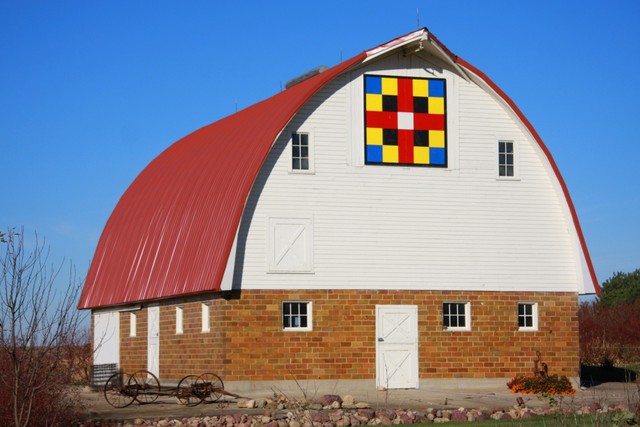
Sac County barn quilt near Early, Iowa
Want more?
Thanks for stopping by. I invite you to read more of my blog posts if you value intriguing Iowa stories and history, along with Iowa food, agriculture updates, recipes and tips to make you a better communicator.
If you like what you see and want to be notified when I post new stories, be sure to click on the “subscribe to blog updates/newsletter” button at the top of this page, or click here. Feel free to share this with friends and colleagues who might be interested, too.
Also, if you or someone you know could use my writing services (I’m not only Iowa’s storyteller, but a professionally-trained journalist with 20 years of experience), let’s talk. I work with businesses and organizations within Iowa and across the country to unleash the power of great storytelling to define their brand and connect with their audience through clear, compelling blog posts, articles, news releases, feature stories, newsletter articles, social media, video scripts, and photography. Learn more at www.darcymaulsby.com, or e-mail me at yettergirl@yahoo.com.
If you’re hungry for more stories of Iowa history, check out my top-selling “Culinary History of Iowa: Sweet Corn, Pork Tenderloins, Maid-Rites and More” book from The History Press. Also take a look at my latest book, “Dallas County,” and my Calhoun County” book from Arcadia Publishing. Both are filled with vintage photos and compelling stories that showcase he history of small-town and rural Iowa. Order your signed copies today! Iowa postcards are available in my online store, too.
Let’s stay in touch. I’m at darcy@darcymaulsby.com, and yettergirl@yahoo.com.
Talk to you soon!
Darcy
@Copyright 2018 Darcy Maulsby & Co. Blog posts may only be reprinted with permission from Darcy Maulsby.
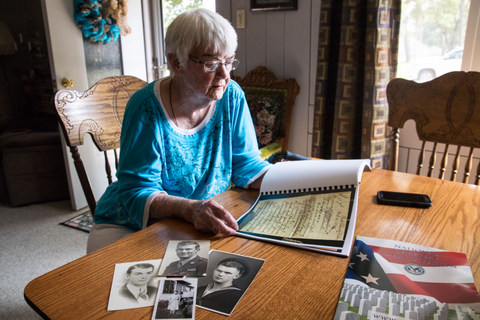
DNA Helps Sailor Killed at Pearl Harbor Return to His Family
It was the telegram no family wanted to receive. “The Navy Department deeply regrets to inform you that your son Bernard Vincent Doyle, seaman second class, U.S. Navy, is missing following action in the performance of his duty and in service of his country.”
The telegram, dated December 20, 1941, was sent to Doyle’s father, John. Weeks later it was confirmed that Bernard “Barney” Doyle, a 19-year-old from Red Cloud, Nebraska, had been killed in action while serving on the battleship USS Oklahoma during the Japanese attack on Pearl Harbor on December 7, 1941.
The loss still lingers. “My brother was the most caring person I knew,” said Fran Nutter, 94, Doyle’s younger sister who has lived in Lake City since 1947. “He was always happy, and everyone liked him.”
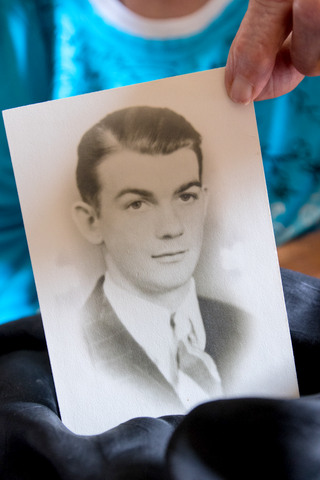
Bernard Doyle, sailor, USS Oklahoma, killed in action at Pearl Harbor
Doyle was buried with full military honors at the Lake City Cemetery around noon on October 13, 2018, following a Mass of the Christian burial at St. Mary’s Catholic Church in Lake City at 11 a.m. High-ranking members of the U.S. Navy attended the services, which were open to the public.
While Doyle’s remains had been classified as non-recoverable, a new chapter in his story is being written, thanks to advances in DNA technology that allowed his remains to be identified and returned to his family. Gov. Kim Reynolds ordered that all flags in Iowa fly at half-staff from sunrise to sunset on October 13 to honor Doyle.
All this support is comforting to Nutter and her family. “I always kept Bernard’s picture on display in my home,” she said. “My family thinks he’s a hero.”
Service and sacrifice
Bernard Doyle was born in Esbon, Kansas, on January 17, 1922, and grew up on a farm with his six brothers and sisters. The family lived in south-central Nebraska, not far from where their grandfather John Doyle homesteaded in Kansas, said Nutter, who remembers the hardships of the Great Depression. “Those were the days when Dad put molasses on tumbleweeds for the cattle to eat.”
After graduating from Red Cloud High School in 1940, Bernard Doyle enlisted in the U.S. Navy on May 28, 1940, in Omaha. He was later assigned to the USS Oklahoma, which was part of the U.S. Pacific Fleet.
The USS Oklahoma arrived in Pearl Harbor on December 6, 1940, one year and one day before to the fateful attack. The USS Oklahoma was on Battleship Row on the morning of December 7, 1941, when Japanese forces attacked Pearl Harbor. The Japanese used dive–bombers, fighter–bombers and torpedo planes to sink nine ships, including five battleships.
The crew of the USS Oklahoma did everything they could to fight back, according to the official website of the USS Oklahoma. In the first 10 minutes of the battle, though, eight torpedoes hit the USS Oklahoma, and she began to capsize. A ninth torpedo hit her as she sunk in the mud.
More than 2,400 Americans died during the Pearl Harbor attacks, including 429 men on the USS Oklahoma. In the aftermath of the tragedy, however, families back home didn’t know if their loved ones had survived or perished.
“After I heard the news, I had a feeling my brother would be okay,” said Nutter, who was working at an ammunition depot in Denver, Colorado, at the time. “I had no idea how serious things really were.”
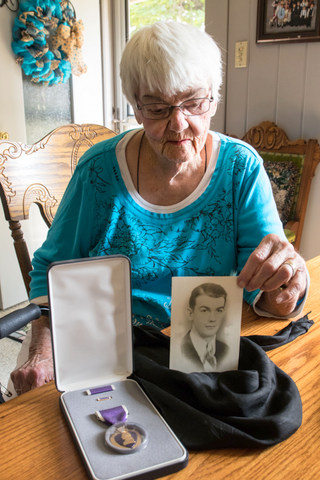
Fran Nutter displays her older brother Bernard’s picture and his Purple Heart.
In the weeks following the Pearl Harbor attack, the remains of men lost aboard the USS Oklahoma were recovered, and 35 were identified. Doyle was not among them, though. “For two months, my parents had no word about my brother’s fate,” said Nutter, who has a note her parents wrote to the Navy on February 10, 1942.
John and Mary Ellen Doyle’s pain is clear in the letter, which reads, “Others from Red Cloud, Nebr., whose sons were there have heard concerning them. We ask you to please give the matter your immediate attention.”
“You can almost sense the desperation in my mother’s letter,” Nutter said.
By Feb. 13, 1942, Rear Admiral Randall Jacobs notified the Doyle family that “after an exhaustive search, it has been found impossible to locate your son…and he has therefore been officially declared to have lost his life in the service of his country as of Dec. 7, 1941.”
Doyle and hundreds of other “unknowns” were buried at the National Memorial Cemetery of the Pacific located at Punchbowl Crater in Honolulu, Hawaii. “My mother accepted that this was God’s way of taking my brother,” Nutter said. “I never thought Bernard would be found, and I wondered what he went through in his last moments.”
All four of Nutter’s brothers, including Johnnie, Bernard, Eugene and Robert, served in various branches of the military during World War 2, including the Army, Navy and Marines. Of the four, only Bernard Doyle never returned.
“I know for a fact that Bernard’s death inspired my brother Eugene to enlist,” said Nutter, who added that Eugene Doyle was a 17-year-old high school student at the time and needed his parents’ consent.
“I thank God”
Memories of Bernard Doyle, who was awarded the Purple Heart, never faded among his family. When Nutter and her late husband, Dean, traveled to Hawaii for their 45th wedding anniversary in the late 1980s, they visited the Punchbowl and saw Bernard Doyle’s name on a memorial. “I didn’t know his name was there, and I started to cry,” Nutter said.
By 2003, the U.S. military started trying to identify individual remains of U.S. service members killed at Pearl Harbor. The process was difficult, however, since DNA technology was not as advanced as it is today. Also, remains of deceased service members were sometimes mixed together. In some cases, the partial remains of more than 100 service members were placed together in one casket.
As DNA technology advanced, the military renewed efforts to identify those killed at Pearl Harbor. In 2015, all remaining caskets at the Punchbowl that were associated with the USS Oklahoma were exhumed. The remains were transferred to laboratories in Hawaii and Offutt Air Force Base in Nebraska.
In 2015, a representative from the military called Nutter to update her and send her a DNA kit. Nutter and various family members, including her daughter Deanne Grantham of Lake City, didn’t hesitate to provide DNA samples. “I thought, ‘Good, we’re on the right track,’” Nutter said.
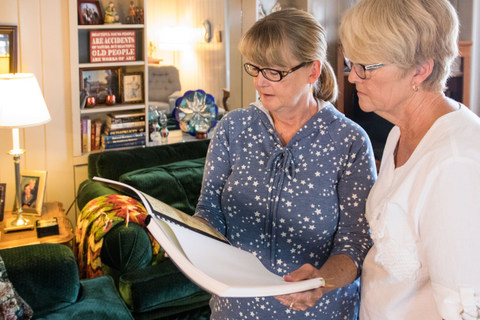
Deanne Grantham (left) and her sister Pat Albright of Lake City, Iowa, review information supplied about their uncle from the U.S. Navy.
Doyle was positively identified by dental remains and an incomplete skeleton in very good condition, said Chief DeShannon Beaty with the U.S. Navy, who visited Nutter and her family in Lake City in August 2018 to share the findings. “It’s interesting and humbling to be part of this,” said Beaty, who noted that some families like the Nutters embrace this history, while others show little interest in the identification of their ancestor’s remains.
Nutter wonders if Doyle might have become a teacher had he lived. “He was so patient,” she said.
In 2017, the family purchased a headstone for Bernard Doyle. Now he’ll be honored properly during the October 13 ceremony, said Nutter, who has gained a new appreciation for the U.S. military after going through this experience. “I thank God so many times for everyone who helped identify my brother so we could bring him home.”
Darcy’s note: It was an honor to share this story of the Nutter family and Bernard Doyle, since the family members are close friends of mine. This article originally ran in the Fort Dodge Messenger. Thank you to all our servicemen and women who protect America.
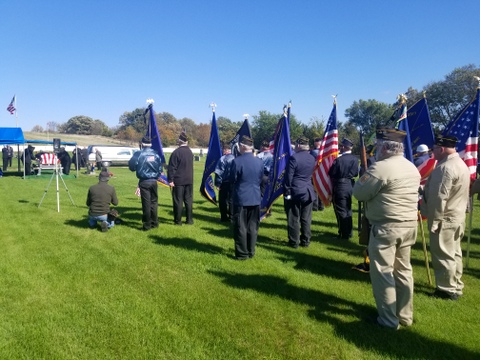
The funeral for sailor Bernard Doyle, killed at Pearl Harbor, was held Oct. 13, 2018, in Lake City, Iowa, with full military honors.
Want more?
Thanks for stopping by. I invite you to read more of my blog posts if you value intriguing Iowa stories and history, along with Iowa food, agriculture updates, recipes and tips to make you a better communicator.
If you like what you see and want to be notified when I post new stories, be sure to click on the “subscribe to blog updates/newsletter” button at the top of this page, or click here. Feel free to share this with friends and colleagues who might be interested, too.
Also, if you or someone you know could use my writing services (I’m not only Iowa’s storyteller, but a professionally-trained journalist with 20 years of experience), let’s talk. I work with businesses and organizations within Iowa and across the country to unleash the power of great storytelling to define their brand and connect with their audience through clear, compelling blog posts, articles, news releases, feature stories, newsletter articles, social media, video scripts, and photography. Learn more at www.darcymaulsby.com, or e-mail me at yettergirl@yahoo.com.
If you’re hungry for more stories of Iowa history, check out my top-selling “Culinary History of Iowa: Sweet Corn, Pork Tenderloins, Maid-Rites and More” book from The History Press. Also take a look at my latest book, “Dallas County,” and my Calhoun County” book from Arcadia Publishing. Both are filled with vintage photos and compelling stories that showcase he history of small-town and rural Iowa. Order your signed copies today! Iowa postcards are available in my online store, too.
Let’s stay in touch. I’m at darcy@darcymaulsby.com, and yettergirl@yahoo.com.
Talk to you soon!
Darcy
@Copyright 2018 Darcy Maulsby & Co. Blog posts may only be reprinted with permission from Darcy Maulsby.
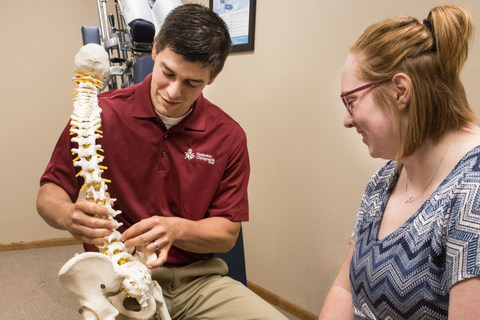
Young Entrepreneur Grows a Healthy Business in Small-Town Iowa
It’s no secret that rural Iowa has suffered through decades of population loss. The current trends are sobering, when you see data from the U.S. Census Bureau showing that two-thirds of Iowa counties (that’s 71 counties, including my home county of Calhoun County in west-central Iowa) lost population between 2010 and 2017, while 28 saw gains. So what would attract a young entrepreneur to an area like Calhoun County?
It’s a question I asked Dr. Jeff Redenius, who opened Redenius Chiropractic, PLC, in my hometown of Lake City (population 1,700) in 2016. Not only has this native son grown his customer base at his thriving chiropractic clinic, which is housed in the former variety store on Main Street, but perhaps the biggest surprise of all is the popularity of his attached 24-hour fitness center. So what’s the secret of this dynamic entrepreneur’s success? Here’s his story, which I shared in the 2018 Hometown Pride section of the Fort Dodge Messenger.
Back to Health:
Dr. Jeff Redenius Promotes Fitness, Wellness for All Ages
Jeff Redenius had enough to worry about as final exams loomed during his senior year at Central College in Pella. As he studied for his tests, however, the Lake City native suddenly felt like a knife was plunging into his chest.
“It was so intense I couldn’t take a deep breath,” said Redenius, 28, who owns Redenius Chiropractic, PLC, and a 24-hour fitness center in Lake City. “I went to a chiropractor and found out I had a rib out of place.”
A quick adjustment provided effective relief. Redenius learned that displaced ribs are fairly common and can be triggered by stress. “I typically see at least one patient each day with a displaced rib,” said Redenius, who opened his chiropractic clinic along Main Street in Lake City in August 2016.
Redenius’s own ordeal with pain prompted him to pursue a career in chiropractic care. “I was amazed at how much relief I experienced by going to the chiropractor,” he said. “I had known since high school that I wanted to go into health care, but this experience helped me clarify which area of health care to specialize in.”
Becoming a business owner
Redenius first discovered the value of high-quality health care close to home when he tore the anterior cruciate ligament (ACL) in his knee while playing football during his junior year of high school.
“I went to the hospital for physical therapy and began to appreciate all the medical care we have right here in Lake City,” said Redenius, who graduated from Southern Cal High School in Lake City in 2008.
After earning his bachelor of science degree in athletic training from Central College in in 2012, he wasn’t sure whether he wanted to pursue an advanced degree in physical therapy or chiropractic care. His displaced rib during final exams, along with his desire to own his own business, prompted his decision to enroll at the Palmer College of Chiropractic in Davenport.
“My dad, Gary, is a carpenter and has run his business for years, and I wanted to follow in his footsteps,” added Redenius, who had often worked with his father on construction projects through the years.

During Redenius’s years at Palmer, he served as the head athletic trainer and worked with the Palmer men’s and women’s rugby teams. After graduating from Palmer in February 2016, he and his wife, Jenny, a Hudson, Iowa, native, assessed their options about their next career moves.
The couple considered moving to Waverly, since it’s a growing community and a college town, but it proved more affordable for Redenius to open his chiropractic clinic in his hometown, especially when the local dime store on Main Street came up for sale.
“I knew a lot of people around here, which I figured would help grow my business faster,” Redenius said. “We also like the affordable cost of living and the chance to be close to family and raise our son, Sam, here.”
Fitness center proves popular
With approximately 5,500 square feet in the former dime store, the spacious building offered room for more than just a chiropractic clinic with exam rooms, a therapy room and an x-ray room. When Jenny suggested adding a fitness center, Redenius didn’t think it was feasible. “It was a great idea, but I was so overwhelmed by opening the chiropractic clinic that I didn’t think I could take on another project.”
Then Redenius found out that the Palmer College of Chiropractic was building a new fitness center and was willing to sell all the equipment from the former fitness center, including the free weights, the cable machines and the elliptical trainers, for a great deal. He rounded up some strong helpers, lined up a semi-truck and moved all the gym equipment to his building in Lake City.
After some remodeling, Redenius’s new 24-hour fitness center was ready for business. “We opened the fitness center in June 2016, a few months before I opened my chiropractic clinic in August that year,” Redenius said.
Some fitness center members like to take exercise classes and work with a personal trainer, while others like Mary Fern like to design their own workout routine. “I come here five to six days a week,” said Fern, 91, who moved to Lake City in August 2017. “It’s convenient, plus I like the variety.”
Fern walks laps in the gym, uses the cable machine to strengthen her arms and works out on the NuStep, which looks similar to an exercise bike and offers a safe, low-impact way to get a total-body workout. “Why do I exercise? If you don’t use it, you lose it,” she said.
Fern is a walking example of the power of healthy living, said Redenius, who features a quote from Thomas Edison on the wall of his reception area. “The doctor of the future will give no medication but will interest his patients in the care of the human frame, diet and in the cause and prevention of disease.”
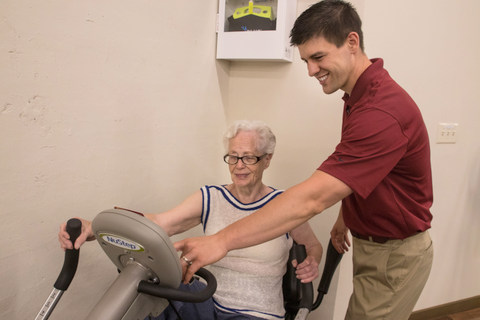
Dr. Jeff Redenius promotes fitness for all ages. Mary Fern is 91 years young and follows a “use it or lose it” exercise and wellness philosophy.
“We’ve only started to make our mark”
While fitness and chiropractic care go hand in hand, along with massage therapy services provided at Redenius Chiropractic by therapist Haley Abbott, Redenius doesn’t hesitate to refer patients to other health-care providers, when necessary.
Redenius is also seeking new ways to promote healthy living, including a new weight-loss program he began offering this summer. The four-stage program includes a meal plan and weekly coaching to help patients reach a healthier weight. “You only have one body, and I’m more about preventing disease than fixing problems.”
That spirit of service also extends to Redenius’s hobbies and work in the community. In 2017, he purchased the Baptist Church complex in Lake City after the congregation joined with the Woodlawn Christian Church in Lake City. He has been remodeling the education wing into two apartments. One unit has been rented, and the other is available for rent.
“I like to build things and create positive change, from people’s health to my business to the local community,” Redenius said. “We’ve only started to make our mark.”
Want more?
Thanks for stopping by. I invite you to read more of my blog posts if you value intriguing Iowa stories and history, along with Iowa food, agriculture updates, recipes and tips to make you a better communicator.
If you like what you see and want to be notified when I post new stories, be sure to click on the “subscribe to blog updates/newsletter” button at the top of this page, or click here. Feel free to share this with friends and colleagues who might be interested, too.
Also, if you or someone you know could use my writing services (I’m not only Iowa’s storyteller, but a professionally-trained journalist with 20 years of experience), let’s talk. I work with businesses and organizations within Iowa and across the country to unleash the power of great storytelling to define their brand and connect with their audience through clear, compelling blog posts, articles, news releases, feature stories, newsletter articles, social media, video scripts, and photography. Learn more at www.darcymaulsby.com, or e-mail me at yettergirl@yahoo.com.
If you’re hungry for more stories of Iowa history, check out my top-selling “Culinary History of Iowa: Sweet Corn, Pork Tenderloins, Maid-Rites and More” book from The History Press. Also take a look at my latest book, “Dallas County,” and my Calhoun County” book from Arcadia Publishing. Both are filled with vintage photos and compelling stories that showcase he history of small-town and rural Iowa. Order your signed copies today! Iowa postcards are available in my online store, too.
Let’s stay in touch. I’m at darcy@darcymaulsby.com, and yettergirl@yahoo.com.
Talk to you soon!
Darcy
@Copyright 2018 Darcy Maulsby & Co. Blog posts may only be reprinted with permission from Darcy Maulsby.
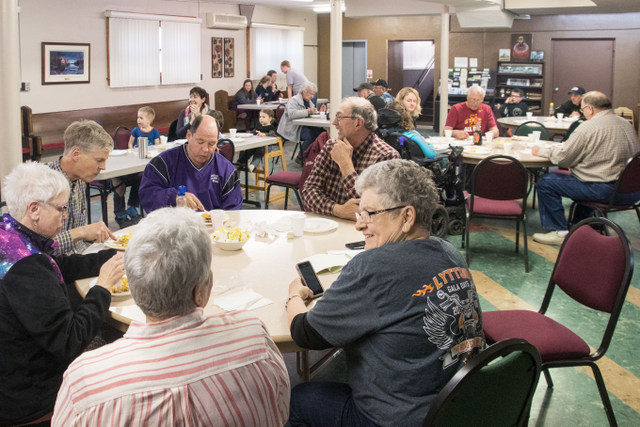
Doing Good, Eating Good at Lytton Town Night
What’s the glue that keeps a community connected? Around Lytton, Iowa, it’s food and fun at Lytton Town Night–and the homemade pie, of course.
While Lytton, Iowa, celebrates Gala Days each year during Memorial Day weekend, planning and fundraising for this beloved 100+ year tradition starts months earlier. In fact, a key part of the process starts in that most iconic of all small-town gathering places—the church basement.
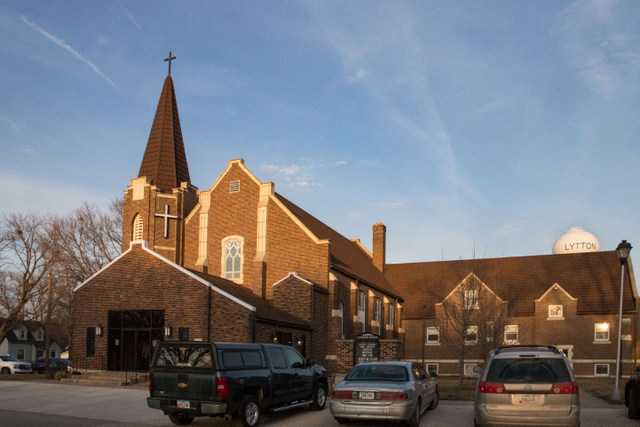
Emanuel-St John Lutheran Church in Lytton, Iowa, hosts Lytton Town Night meals throughout the winter.
The basement dining area at Emanuel-St John Lutheran Church, whose congregation has roots dating back to 1883, provides a convenient setting for Lytton Town Night, which is held each Thursday evening from mid-January through March. Each Town Night offers a unique opportunity for the community to come together for free-will-donation meal to raise money for various causes and organizations, including Gala Days.
“Town Night is great, because there are a lot of fabulous cooks around Lytton,” said Nelda Bartels, a lifelong Lytton-area resident who often volunteers at Town Night.
As word of Town Night has spread through the years, guests come not only from Lytton, but Lake City, Sac City, Rockwell City and beyond. It’s not uncommon to serve a few hundred people at each meal.
“It’s like one big family when everyone gets together,” said Wendy Miller with the Lytton Chamber of Commerce.
Lytton Town Night includes groups like the Gala Days volunteers, the South Central Calhoun FFA chapter, 4-H clubs, civic groups and individuals raising money for worthy causes, including overseas mission trips. The Lytton Chamber of Commerce coordinates the schedule for Town Night, which allows eight to 10 different groups and individuals to host a Town Night meal during the winter, complete with home-cooked food. Some groups serve a selection of pasta casseroles, while others like the local FFA members serve pancakes and sausage links.
“I like the food, because it’s all good,” said Randy Souder, a Lytton-area farmer. “It’s also affordable, so everyone can come.”
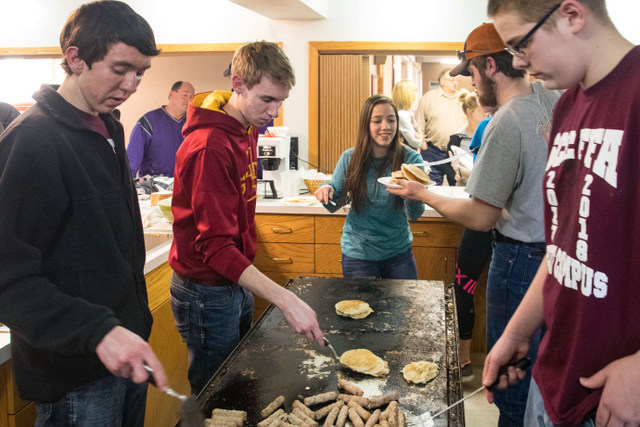
Members of the South Central Calhoun FFA chapter cooked pancakes and sausage during a Lytton Town Night fundraiser.
While no one is quite sure when Lytton Town Night started, it has been around since at least 1980, according to local-time residents. “It’s such a fun event, because you get to visit with friends and neighbors you don’t always see,” said Marlene Glasnapp, who lives with her husband, Roger, on a farm south of Lytton and is known as one of the best pie bakers in the area.
Each Town Night event is promoted through the Lytton Town Crier and on social media through Facebook. Each meal runs from 5 p.m. to 7 p.m. each Thursday evening during the winter. The popular gatherings attract people of all ages, from babies to grandparents.
Some groups, like the Gala Days volunteers, serve a lunch and a dinner meal when it’s their turn to host Town Night. “We usually have casseroles and homemade pie,” Bartels said. “The homemade pie is the kicker, because it’s always a hit.”
When the meal is done, the fellowship continues in downtown Lytton at the 1950s-era American Legion hall for bingo. “Town Night bingo has been called Lytton’s winter sport,” Bartels said.
The evening of bingo lasts about an hour and a half, and participants can play as many cards as they want. Two cards cost $3, and the proceeds support the American Legion.
Town Night isn’t just a fun evening, added Brian Lantz, an ag instructor at South Central Calhoun High School who advises the local FFA chapter. “It’s a local tradition, plus the kids learn how to work with the public when it’s their turn to cook and serve the meal.”
Keeping the Town Night tradition alive is important to residents of Lytton, which has a population of 302 residents. “Every year we wonder if we’ll be able have Town Night again,” Miller said. “We’re going to keep it going as a long as we can.”

Creamy Chicken Pasta Casserole
Creamy Chicken Casserole
This simple, hearty dish from Nelda Bartels of Lytton was served at the Gala Days fundraiser at Lytton Town Night in March 2018.
3 boneless, skinless chicken breasts, cooked and shredded
1 teaspoon garlic powder
1 tablespoon olive oil
1 10.75-ounce can cream of chicken soup
1 10.75-ounce can cream of mushroom soup
1 cup milk
1 bag (2 cups) shredded Cheddar cheese
1 / 2 teaspoon ground black pepper
1-pound box elbow macaroni (cooked according to package directions)
1 1 / 2 cups panko bread crumbs or regular bread crumbs
Preheat oven to 350 degrees. Cook chicken with garlic powder. (Nelda uses a programmable pressure cooker and adds a couple cups of chicken broth.) Drizzle with olive oil. When done, shred chicken with a fork, and save the juice.
Combine the two cream soups, milk, cheese, cooked chicken, broth from chicken and pepper. (If desired, add some sour cream or cream cheese into the mixture for extra flavor and creaminess.) Add cooked macaroni. Stir the mixture and pour into a 9-inch by 13-inch casserole pan.
Top casserole with panko breadcrumbs. Bake at 350 degrees for 20 to 25 minutes. Brown panko topping under broiler on low for 3 to 5 minutes. Watch closely, since the breadcrumbs can burn quickly.
Bowtie Lasagna Casserole
This tasty recipe comes from Nelda Bartels of Lytton.
1 jar spaghetti sauce
1 to 1.5 pounds ground beef
1 package bowtie pasta noodles (cooked according to package directions)
1 small carton cottage cheese
1 8-ounce package cream cheese
1 small carton sour cream
Mozzarella cheese
Preheat oven to 350 degrees. Brown hamburger; mix with spaghetti sauce. Pour sauce on bottom of 9-inch by 13-inch baking pan. Combine hamburger and bowtie pasta. Combine cottage cheese, cream cheese, and sour cream. Add to hamburger/pasta mix; pour in baking pan. Top with mozzarella cheese.
Bake at 350 degrees for 45 minutes to 1 hour.
Poppy Seed Chicken
This recipe comes from Susan Albright of Lytton.
4 chicken breasts, cooked and cubed
1 carton (16 ounces) sour cream
1 10.75-ounce can cream of chicken soup
Very small handful of spaghetti, broken into pieces and cooked (Susan Albright uses three fourths of a box of angel hair pasta)
1 stick butter
40 Ritz crackers, crushed
1 / 2 tablespoon poppy seeds
Preheat oven to 350 degrees. After cooking chicken, season to taste with garlic salt and onion. Combine sour cream and soup. Add cubed chicken and cooked spaghetti to mixture. Add salt, to taste.
Pour mixture into greased, 9-inch by 13-inch baking dish.
In a separate bowl, melt butter; add crushed crackers and poppy seeds. Sprinkle cracker mixture on top of casserole. Bake for 20 minutes.
Pie Crust
For decades, Marlene Glasnapp of rural Lytton has relied on this recipe, which yields approximately 6 crusts per batch.
5 cups flour
1 teaspoon salt
1 pound lard
1 cup water
Combine flour and salt. Cut lard into the flour mixture. Add water, a little at a time, mixing quickly and evenly until dough just holds together in a ball. Divide dough for six crusts. (The crusts can be frozen for later use, and Marlene often rolls hers out before freezing.)

Raisin Cream Pie
Marlene Glasnapp’s raisin cream pie is always a hit wherever it’s served.
1 cup granulated sugar
3 tablespoons flour
1 / 2 teaspoon salt
1 teaspoon cinnamon
2 cups half-and-half
3-4 egg yolks (depends on the size of the eggs)
1 cup raisins
Mix dry ingredients with 1 / 2 cup of half-and-half, and set aside. Whisk egg yolks, and combine remaining half-and-half with the yolks. Add this mixture to the pie filling mix you set aside earlier.
Add raisins to the mixture and stir over medium heat until thick. Cool slightly. Pour in baked pie shell and top with meringue.
Meringue
1 tablespoon cornstarch
1 / 2 cup plus 1 tablespoon water
3 to 4 egg whites (depending on the size of the eggs)
3 to 4 tablespoons granulated sugar
Dissolve 1 tablespoon of cornstarch in 1 tablespoon of water. Boil 1 / 2 cup water and add to cornstarch mixture. Cook until clear. (This can be done in the microwave.) Beat egg whites and gradually add sugar. Add cooled cornstarch mixture and beat to proper consistency. Spread meringue over top of pie, sealing to the edge. Bake pie at 350 degrees Fahrenheit until meringue has browned.
Note from Darcy: I first wrote this piece in 2018 for Farm News.
Want more?
Thanks for stopping by. I invite you to read more of my blog posts if you value intriguing Iowa stories and history, along with Iowa food, agriculture updates, recipes and tips to make you a better communicator.
If you like what you see and want to be notified when I post new stories, be sure to click on the “subscribe to blog updates/newsletter” button at the top of this page, or click here. Feel free to share this with friends and colleagues who might be interested, too.
Also, if you or someone you know could use my writing services (I’m not only Iowa’s storyteller, but a professionally-trained journalist with 20 years of experience), let’s talk. I work with businesses and organizations within Iowa and across the country to unleash the power of great storytelling to define their brand and connect with their audience through clear, compelling blog posts, articles, news releases, feature stories, newsletter articles, social media, video scripts, and photography. Learn more at www.darcymaulsby.com, or e-mail me at yettergirl@yahoo.com.
If you’re hungry for more stories of Iowa history, check out my top-selling “Culinary History of Iowa: Sweet Corn, Pork Tenderloins, Maid-Rites and More” book from The History Press. Also take a look at my latest book, “Dallas County,” and my Calhoun County” book from Arcadia Publishing. Both are filled with vintage photos and compelling stories that showcase he history of small-town and rural Iowa. Order your signed copies today! Iowa postcards are available in my online store, too.
Let’s stay in touch. I’m at darcy@darcymaulsby.com, and yettergirl@yahoo.com.
Talk to you soon!
Darcy
@Copyright 2018 Darcy Maulsby & Co. Blog posts may only be reprinted with permission from Darcy Maulsby.

